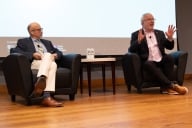You have /5 articles left.
Sign up for a free account or log in.

Educause CEO John O'Brien speaks during the organization's annual conference.
Educause
ANAHEIM, Calif. -- Educause wants to get to know its members.
The higher education IT organization will over the next five years focus on collaboration, personalization and professional development in order to create an experience that is more “inclusive, equitable and simplified,” according to a new strategic plan.
“We’re changing the Educause experience in many of the same ways you’re being asked to change on your campus,” CEO John O’Brien said Thursday to the thousands of IT staffers attending the organization’s annual conference here this week. “We’ll navigate this future together.”
The strategic plan is the clearest indication yet of in what direction O’Brien, who became CEO in June 2015, intends to take Educause. The organization has more than 2,300 member institutions and 300 corporate partners around the world, and its events, research and policy work help set the agenda for the role of IT in higher education.
Speaking to Inside Higher Ed last October, O’Brien said he intended to pursue “ambitious but achievable goals” and avoid creating a strategic plan that was either full of rhetorical flourishes or one that would end up as a paperweight.
O’Brien’s presentation on Thursday showed some signs of that approach. He breezed through the strategic plan’s three priorities and changes to Educause’s membership model in about six minutes. But it was also an aspirational speech; O’Brien used variations of the world “imagine” 10 times as he listed the ways he plans for Educause to change over the next five years.
The strategic plan’s first priority, personalization, is likely to come as relief to anyone overwhelmed by the conference’s hundreds of exhibitors and sessions and thousands of attendees -- not to mention the research and teaching and learning resources Educause offers outside the conferencing space.
Educause will take a more proactive and tailored approach to disseminating knowledge through a new network that will learn about each member’s habits, according to the plan. For future conferences, O’Brien said, Educause could potentially send each individual attendee a list of recommended sessions based on their interests, or forward them relevant research based on the issues they are grappling with on their campuses.
“For those of us in college some time between mood rings and the internet, we remember the biggest challenge was simply finding information,” O’Brien said, reflecting on when, as a college student, he relied on browsing the library stacks to find articles and books. “Yesterday we were thirsty for information. Today we’re drowning in it.”
In a follow-up interview Thursday, O’Brien said Educause hasn’t yet decided what technology it will use to achieve that level of personalization, but that it could be as simple as adding questions about concerns and interests to members’ profile pages. The organization has behind the scenes updated its website and content management system in preparation of a more personalized way to communicate with members.
Educause will also strengthen its professional development programs, both with more specialized paths (O’Brien mentioned tracks for chief information security and digital officers as potential examples), new delivery methods -- such as a team-based model -- and a concierge service that finds the best program based on personal preference.
“We’ve heard loud and clear that so many of you look to Educause to grow and advance as professionals,” O’Brien said. “Technology and IT roles and responsibilities are in motion now more than ever, and we’re going to reimagine professional development over the next few years to help you keep pace.”
O’Brien also said Educause will continue to work with other associations and organizations, as “IT is inextricably interconnected across our higher education ecosystem, and our success depends more than ever on strategic partnerships and collaboration.” Educause has, among other partnerships, worked with the Bill and Melinda Gates Foundation on the Next Generation Learning Challenges program, the National Association of College and University Business Officers on co-hosting events, and teamed up with higher education, technology and library associations to speak with one voice on policy matters such as regulating the internet.
Collaborating with outside groups could help IT departments more clearly demonstrate the benefits they provide to colleges and give them an opportunity to participate in conversations about strategic academic decisions, O’Brien said.
“The future of IT is not IT talking to itself,” O’Brien said in the interview, during which he brought up research showing only 35 percent of chief information officers feel involved in that decision-making process. “The future is talking across the C suite.”
Educause considered adding diversity as a stand-alone fourth priority, but decided instead to embed it in the other three, O’Brien said.
The changes introduced by the strategic plan will come with a simplified membership structure, O’Brien said. Today, Educause determines membership fees -- which range from $560 to $9,315 -- based on a college’s Carnegie classification and enrollment, while associations, corporations and colleges outside North America are charged flat fees. Membership in the Educause Learning Initiative (ELI) and a subscription to the Educause Center for Analysis (ECAR) costs thousands of dollars more.
That structure will be scrapped in favor of a system that looks at a college’s size, type and operating budget, O’Brien said. Starting in July, all members will be able to access research from ECAR and resources from ELI (an announcement met with applause from conference attendees).
As O’Brien jokingly pointed out seconds later, no one applauded when he mentioned how that change would impact membership fees. Educause will recoup the loss of income from ECAR subscriptions and ELI memberships by spreading the costs across its membership, he later explained. Colleges already paying for those resources will likely see their dues go down, while those who don’t may see a slight increase, he said.
In the follow-up interview, O’Brien addressed the rampant commercialization present at the annual conference -- everything from corporate-branded coffee breaks and advertising space on escalators to exhibit hall magicians and giveaways of light-up plastic swords. He described the balance between serving the needs of nonprofit college and corporate members as “productive tension,” but added that a strong vendor presence at the conference is not “inherently problematic.”
Besides, O’Brien added, visitors keep returning to the conference. This year, nearly 8,000 people attended.
“The reality is people don’t come back year after year because we’re big or because of the magicians or because of the plastic swords,” O’Brien said. “You’ve got to cross a few swords and magicians, but there are substantive, meaningful conversations that are happening.”








